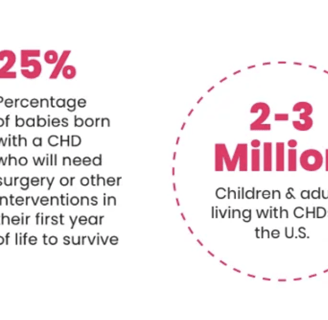Congenital Heart Defects: Key Facts Every Parent and Advocate Should Know
Congenital Heart Defects (CHD) affect nearly 1 in 100 babies born each year, making it the most common birth defect. CHD includes a range of heart conditions, from mild to severe, and often requires lifelong care. Thanks to medical advancements, over 85% of children with CHD now survive into adulthood. Raising awareness, supporting research, and advocating for funding are critical to improving outcomes and ensuring a brighter future for those impacted by CHD. Together, we can make a difference.
1/12/20253 min read


Congenital Heart Defects (CHD) are the most common type of birth defect, yet awareness about them is often limited. Understanding the facts about CHD can empower families, caregivers, and advocates to navigate this journey, support loved ones, and raise awareness. Here are some important facts about CHD that everyone should know.
1. CHD Is the Most Common Birth Defect
CHD affects nearly 1 in 100 babies born in the United States each year, making it the most common congenital anomaly.
Over 40,000 babies are born with CHD annually in the U.S., and millions of adults and children are living with CHD worldwide.
2. There Are Many Types of CHD
CHD is not one single condition but a group of structural heart defects that can range from mild to severe. Common types include:
Atrial Septal Defect (ASD): A hole in the wall between the heart's upper chambers.
Ventricular Septal Defect (VSD): A hole in the wall between the lower chambers.
Tetralogy of Fallot (ToF): A complex defect involving four abnormalities.
Transposition of the Great Arteries (TGA): When the main arteries are reversed.
Some defects may require surgery, while others can be managed with medication or regular monitoring.
3. The Cause of CHD Is Often Unknown
In most cases, the exact cause of CHD is unclear. It can result from a combination of genetic and environmental factors.
Some cases are linked to genetic syndromes, maternal illnesses, or exposure to harmful substances during pregnancy.
4. CHD Is a Lifelong Condition
While many children undergo surgeries or treatments that repair their heart defects, CHD is often a lifelong condition requiring ongoing care.
Adults with CHD often benefit from specialized cardiology follow-ups to manage their heart health.
5. Medical Advancements Have Improved Outcomes
Over the past few decades, advancements in pediatric cardiology and cardiac surgery have significantly improved survival rates for children with CHD.
Today, more than 85% of babies born with CHD survive into adulthood, compared to much lower survival rates just a few decades ago.
6. CHD Is the Leading Cause of Infant Deaths Due to Birth Defects
CHD accounts for approximately 25% of infant deaths related to congenital anomalies.
Early detection and intervention are critical in improving outcomes for children with CHD.
7. CHD Can Be Diagnosed Before Birth
Many congenital heart defects can be detected during pregnancy through advanced ultrasounds or fetal echocardiography.
Early diagnosis allows parents and medical teams to prepare for the necessary interventions and care immediately after birth.
8. CHD Is Not Preventable, But Risk Factors Can Be Managed
While CHD cannot be entirely prevented, managing certain maternal risk factors during pregnancy can help:
Avoiding alcohol, tobacco, and harmful medications.
Managing pre-existing conditions like diabetes or infections.
Taking folic acid supplements to reduce the risk of birth defects.
9. CHD Research and Funding Are Essential
Despite its prevalence, CHD receives less research funding compared to other childhood diseases.
Advocacy for increased funding and awareness is vital to advance treatments and improve the quality of life for those with CHD.
10. Awareness Saves Lives
Spreading awareness about CHD helps families recognize the signs and seek timely medical care. Symptoms to watch for include:
Rapid breathing or difficulty feeding in infants.
Poor weight gain or fatigue during physical activity.
Cyanosis (a bluish tint to the skin, lips, or nails).
How You Can Support CHD Awareness
Share the Facts: Help educate others by sharing CHD information on social media or within your community.
Participate in CHD Awareness Week: Every February, events and campaigns aim to bring CHD into the spotlight.
Donate to CHD Organizations: Support research, medical advancements, and family assistance programs.
Advocate for Funding: Encourage policymakers to prioritize CHD research and resources.
Congenital Heart Defects affect millions of people, yet they often don’t receive the attention they deserve. By spreading awareness, supporting research, and celebrating the resilience of CHD warriors, we can make a difference in the lives of children and families navigating this condition. Together, we can help create a brighter future for everyone impacted by CHD.
